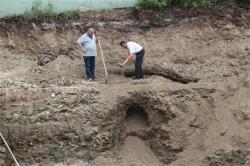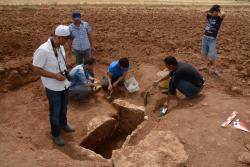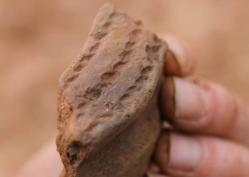INSTITUT SUPERIEUR D'ANTHROPOLOGIE
INSTITUTE OF ANTHROPOLOGY
ONLINE COURSES / COURS A DISTANCE
FALL TERM : OCTOBER 2015
REGISTER NOW
TURQUIE – 
 İlkadım / Nusaybin - A Hellenistic grave has been unearthed at a construction site in the northern province of Samsun’s İlkadım district. The first examinations made by the Samsun Archaeology and Ethnography Museum officials revealed that it was a Hellenistic-era grave chamber. Previously, ancient grave chambers were found during construction in the city’s Baruthane and Kalkanca neighborhoods. In the meantime, a 3rd-century Bronze-age grave has been found in the eastern province of Mardin’s Nusaybin district. Jugs buried around the grave have been also been unearthed by Mardin Museum officials.
İlkadım / Nusaybin - A Hellenistic grave has been unearthed at a construction site in the northern province of Samsun’s İlkadım district. The first examinations made by the Samsun Archaeology and Ethnography Museum officials revealed that it was a Hellenistic-era grave chamber. Previously, ancient grave chambers were found during construction in the city’s Baruthane and Kalkanca neighborhoods. In the meantime, a 3rd-century Bronze-age grave has been found in the eastern province of Mardin’s Nusaybin district. Jugs buried around the grave have been also been unearthed by Mardin Museum officials.
http://www.hurriyetdailynews.com/hellenistic-grave-chamber-found-in-eastern-turkey.aspx?pageID=238&nid=83422&NewsCatID=375
AUSTRALIE –  Kimberley - Australian scientists said Wednesday they have uncovered a "very rare" 2,000-year-old natural sea pearl -- the first found on the vast island continent -- while excavating a remote coastal Aboriginal site. Archaeologists were working the site on the north Kimberley coast of Western Australia when they came across the unique gem below the surface, said Kat Szabo, an associate professor at the University of Wollongong. "Natural pearls are very rare in nature and we certainly -- despite many, many (oyster) shell middens being found in Australia -- we've never found a natural pearl before," Szabo, who specialises in studying shells at archaeological sites, told AFP. A midden is a prehistoric refuse pit.The oysters that produce pearls have been used in rainmaking ceremonies in indigenous cultures, and their shells have been found in the central desert more than 1,500 kilometres (930 miles) away. Archaeologists have known about the rainmaking rituals but were not aware of how far back in history they had been practised.
Kimberley - Australian scientists said Wednesday they have uncovered a "very rare" 2,000-year-old natural sea pearl -- the first found on the vast island continent -- while excavating a remote coastal Aboriginal site. Archaeologists were working the site on the north Kimberley coast of Western Australia when they came across the unique gem below the surface, said Kat Szabo, an associate professor at the University of Wollongong. "Natural pearls are very rare in nature and we certainly -- despite many, many (oyster) shell middens being found in Australia -- we've never found a natural pearl before," Szabo, who specialises in studying shells at archaeological sites, told AFP. A midden is a prehistoric refuse pit.The oysters that produce pearls have been used in rainmaking ceremonies in indigenous cultures, and their shells have been found in the central desert more than 1,500 kilometres (930 miles) away. Archaeologists have known about the rainmaking rituals but were not aware of how far back in history they had been practised.
http://www.dailymail.co.uk/wires/afp/article-3108900/2-000-year-old-natural-pearl-remote-Australian-site.html
AZERBAIDJAN –  Ganja - An expedition group of the Archaeology and Ethnography Institute conducted an intense archaeological research in Ganja city and its surrounding areas in late May. The goal of the expedition led by Head of the Institute department, Farhad Guliyev was the electronic registration of the city’s archaeological monuments and cartographic works. The archaeological research enclosed an area of 300 sq.m. The city territory was investigated with “Google Earth” program and archeological sites were recorded with their GPS coordinates. During the expedition, running from the site of the Ganja airport to the cemetery "Yeni Sebzikar", as well as the entrance to the city until administrative boundaries Goygol, new 62 mounds were discovered and recorded on the card. Mounds are supposed to belong to the Bronze Age and are mostly covered with stones of various sizes. The condition of the findings, territory localization and the size of mounds were written down on the list. According to the expedition’s members it will be necessary to carry out large-scale excavations in the future.
Ganja - An expedition group of the Archaeology and Ethnography Institute conducted an intense archaeological research in Ganja city and its surrounding areas in late May. The goal of the expedition led by Head of the Institute department, Farhad Guliyev was the electronic registration of the city’s archaeological monuments and cartographic works. The archaeological research enclosed an area of 300 sq.m. The city territory was investigated with “Google Earth” program and archeological sites were recorded with their GPS coordinates. During the expedition, running from the site of the Ganja airport to the cemetery "Yeni Sebzikar", as well as the entrance to the city until administrative boundaries Goygol, new 62 mounds were discovered and recorded on the card. Mounds are supposed to belong to the Bronze Age and are mostly covered with stones of various sizes. The condition of the findings, territory localization and the size of mounds were written down on the list. According to the expedition’s members it will be necessary to carry out large-scale excavations in the future.
http://www.azernews.az/azerbaijan/82883.html
ROYAUME UNI –  Tullaghoge Fort - A number of fantastic historical discoveries have been made during a new archaeological dig at Tullaghoge Fort. Historians working on the site found decorated pottery which could be over 7,000-years-old as well as flint artefacts which hint at ancient human habitation on the site. The finds reputedly date from the middle Neolithic up to the early Medieval period and includes pieces of ancient burnt clay cooking vessels. Neolithic residents may have used the site on a temporary basis to take advantage of fishing in the Ballinderry River before moving on to exploit other food sources. It is believed that during the Medieval period the site was inhabited by people from the lower echelons of society. Tullaghoge Fort, which is perched on top of a hill on the outskirts Tullyhogue village, has commanding views of several counties and was ruled by the O’Hagan family who in turn served the O’Neills. It was here that the O’Neill clan crowned their chief, effectively the King of Ulster, until 1607 when the last claimant, Hugh O’Neill, fled to Spain.
Tullaghoge Fort - A number of fantastic historical discoveries have been made during a new archaeological dig at Tullaghoge Fort. Historians working on the site found decorated pottery which could be over 7,000-years-old as well as flint artefacts which hint at ancient human habitation on the site. The finds reputedly date from the middle Neolithic up to the early Medieval period and includes pieces of ancient burnt clay cooking vessels. Neolithic residents may have used the site on a temporary basis to take advantage of fishing in the Ballinderry River before moving on to exploit other food sources. It is believed that during the Medieval period the site was inhabited by people from the lower echelons of society. Tullaghoge Fort, which is perched on top of a hill on the outskirts Tullyhogue village, has commanding views of several counties and was ruled by the O’Hagan family who in turn served the O’Neills. It was here that the O’Neill clan crowned their chief, effectively the King of Ulster, until 1607 when the last claimant, Hugh O’Neill, fled to Spain.
http://www.midulstermail.co.uk/news/local-news/tullaghoge-fort-finds-pre-date-o-neill-clan-1-6777422
POLOGNE –  Stary Bubel - Four-meter boat made from a single piece of wood has been discovered by an accidental finder in the Bug near the village Stary Bubel in the Lublin province. Preliminary analysis of the physicochemical properties suggests that it was made between the fifteenth and mid-seventeenth century.
Stary Bubel - Four-meter boat made from a single piece of wood has been discovered by an accidental finder in the Bug near the village Stary Bubel in the Lublin province. Preliminary analysis of the physicochemical properties suggests that it was made between the fifteenth and mid-seventeenth century.
http://scienceinpoland.pap.pl/en/news/news,405238,centuries-old-dugout-was-discovered-in-the-bug.html
ROYAUME UNI –  Lincoln Castle - Experts have recreated the face of a Saxon man buried at Lincoln Castle almost 1,000 years ago. A team from the University of Dundee was able to create the image from a skeleton discovered on the site of an old church at the castle. He is thought have been about 40 when he died and was one of eight people buried at the site between 1035 to 1070. The position of his grave meant his skull was the best preserved and allowed the experts from the Centre for Anatomy and Human Identification (CAHID) to recreate his face.
Lincoln Castle - Experts have recreated the face of a Saxon man buried at Lincoln Castle almost 1,000 years ago. A team from the University of Dundee was able to create the image from a skeleton discovered on the site of an old church at the castle. He is thought have been about 40 when he died and was one of eight people buried at the site between 1035 to 1070. The position of his grave meant his skull was the best preserved and allowed the experts from the Centre for Anatomy and Human Identification (CAHID) to recreate his face.
http://www.westernmorningnews.co.uk/Face-Saxon-man-recreated-scientists/story-26630559-detail/story.html?